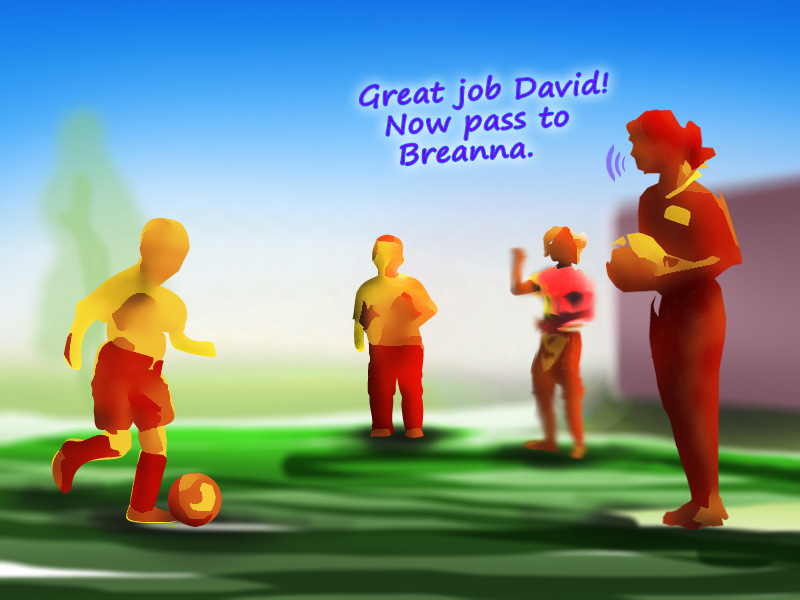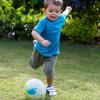- Discuss the importance of physical development and physical activity for preschool children.
- Identify examples of gross motor and fine motor skills in preschool children.
- Discuss how physical development is linked to overall health and learning.
Learn
Know
Our bodies go through amazing transformations when it comes to physical growth and development. Think about the vast physical changes that occur between a newborn baby and a young adult. Recall the different skills you or the children you know were able to do at different ages. Physical activity is very important for our overall development and growth. We use our bodies to explore our environment and learn about the world. Through the movement and coordination of the different parts of our bodies we are better able to access our environment; sitting up, rolling, crawling, walking, running, jumping, and manipulating different materials or objects are examples of ways we are able to further knowledge and exploration in our surroundings. Development of these skills keeps our bodies healthy, fit, and safe.
Physical development refers to the growth and refinement of motor skills, or in other words, children’s abilities to use and control their own bodies. These advancements are evident in gross and fine motor skills, and they are essential to children’s overall health and wellness. Gross motor skills involve the use of large muscles in the legs or arms, as well as general strength and stamina. Gross motor skills include jumping, throwing, climbing, running, skipping, and kicking. Fine motor skills involve the use of small muscles in the arms, hands, and fingers. They are supported by advancements in perception, or the ways in which children use their senses to experience the world around them. Children use their fine motor skills when they string beads, scribble, cut paper, and draw. Fine motor skills also enable children to perform a variety of self-help tasks, such as using utensils and dressing themselves. There is a great deal of variation in the development of fine motor skills (Trawick-Smith, 2014).
Preschool children’s motor abilities develop as a result of physical development. As their bodies mature, children progressively strengthen their muscles and are able to better control their bodies. Skill mastery and development, however, are also the result of brain growth and development. For example, consider a preschooler kicking a ball back-and-forth with a peer or caregiver. This child must have acquired control over muscles and their movement in order to be able to kick the ball. The child also depends upon vision to determine the location, the direction in which to kick the ball, and on hearing for instructions from a peer or caregiver. We will explore the body-brain connection and its impact on children’s overall learning and growth in more detail in Lesson Two (Developmental Milestones) when we examine influences on physical growth and factors that affect children’s physical development.

Physical Activity and Children’s Development
Physical activity is critical for young children’s development. The U.S. Office of Disease Prevention and Health Promotion specifically notes this point in their recently updated guidelines. Two key highlights include these recommendations:
- Preschool-Aged children should be physically active throughout the day to enhance growth and development (and aim for at least 3 hours per day of light, moderate, or vigorous intensity-active play)
- Adult caregivers of preschool-aged children should encourage active play that includes a variety of activity types
(U.S. Dept. of Health and Human Services, 2018).
Because preschool children learn best when they are actively engaged in their environments, it is essential to provide them with ample opportunities to explore the environment by moving, touching, experimenting, and manipulating different toys, objects, and materials. Studies indicate that physical activity in young children is linked to brain growth and development. One study that explored body and brain connections found that preschoolers’ motor-play activities activate visual brain centers (James, 2010). Findings like this suggest that motor activity contributes to the general organization of the brain, ultimately supporting the notion that young children benefit from and require time to be active.
Moreover, physical well-being is also linked to mental health and cognitive development. The World Health Organization defines health as “a state of complete physical, mental, and social well-being and not merely the absence of disease or infirmity.” This definition fundamentally links physical health to mental health. Recent studies have also investigated the influence of physical activity and development on cognition. 80% of studies showed significant and positive changes in language learning, academic achievement, attention, and working memory (Zeng et al. 2017).As you think about young children’s physical development and as you engage with children and their families, keep in mind the role their physical development can play in all areas of development, including mental health and cognition.
See
Watch the video below to learn the importance of movement and physical activity for children’s learning and development.
Movement and Learning in Preschool
Understanding preschoolers’ physical development creates opportunities for you to enhance the care you offer children and their families.
When you foster young children’s physical development, you help them build lifelong skills necessary for wellness, and also a love for physical activity. The Healthy Kids Healthy Future organization provides many tools and resources that you will learn about in this lesson’s Apply activity.
Do
As a preschool teacher, it is your responsibility to help children learn and develop, by providing developmentally appropriate experiences and activities that meet each child’s needs. As you meaningfully plan and implement these goals, you set the foundation for children’s school readiness and success. Your role is important in promoting preschoolers’ gross and fine motor skills as you help them reach their full potential. This means you will want to:
- Give children access to ample opportunities that promote physical development.
- Be responsive to children’s individual needs and differences.
- Establish appropriate expectations about what children should be able to do in terms of physical development and growth that is individualized to them.
Promoting children’s physical development builds a foundation for long-term health and well-being. Learning occurs best when children are actively engaged in meaningful environments and when they use their bodies to explore their surroundings and practice new skills. By encouraging the children in your care to be physically active, you help them develop enjoyment in physical activity and the skills necessary for maintaining their wellness.
Completing This Course
For more information on what to expect in this course, the Physical Development Competency Reflection, and a list of the accompanying Learn, Explore and Apply resources and activities offered throughout the lessons, visit the Preschool Physical Development Course Guide.
Please note the References & Resources section at the end of each lesson outlines reference sources and resources to find additional information on the topics covered. As you complete lessons, you are not expected to review all the online references available. However, you are welcome to explore the resources further if you have interest, or at the request of your trainer, coach, or administrator.
Explore
In the Supporting Physical Development activity below, reflect on your experiences and the physical development of preschoolers. Answer the questions and then share your thoughts and responses with a trainer, coach, or administrator.
Apply
Review the list of resources in the Physical Development Resources for Preschoolers activity to learn strategies for supporting children's motor development through everyday routines and experiences. Reflect on new approaches you can apply in your program to enhance motor skill development. Then, discuss the strategies or experiences you’d like to try with your trainer, coach, or administrator.
Glossary
Demonstrate
Berk, L. E. (2013). Child development (9th ed.). Upper Saddle River, NJ: Pearson.
Centers for Disease Control and Prevention. (2010). The association between school-based physical activity, including physical education, and academic performance. https://www.cdc.gov/healthyyouth/health_and_academics/pdf/pa-pe_paper.pdf
Centers for Disease Control and Prevention, & SHAPE America—Society of Health and Physical Educators. (2017). Strategies for recess in schools. Centers for Disease Control and Prevention, U.S. Department of Health and Human Services. https://portal.shapeamerica.org/uploads/pdfs/recess/SchoolRecessStrategies.pdf
James, K. (2010). Sensori-motor experience leads to changes in visual processing in the developing brain. Developmental Science, 13, 279–288.
Playworks. (2020). Game library. Sports4Kids. https://www.playworks.org/game-library/
Schickedanz, J. A., Hansen, K., & Forsyth, P. D. (2000). Understanding children. Mountain View, CA: Mayfield Publishing Company.
Trawick-Smith, J. W. (2014). Early childhood development: A multicultural perspective (6th ed.). Upper Saddle River, NJ: Pearson Education Inc.
U.S. Department of Health and Human Services, Office of Disease Prevention and Health Promotion. (2020). Physical activity guidelines for Americans (2nd ed.). https://health.gov/sites/default/files/2019-09/Physical_Activity_Guidelines_2nd_edition.pdf
World Health Organization. (1948). Official records of the World Health Organization (No. 2). https://apps.who.int/iris/handle/10665/85573
Zeng, N., Ayyub, M., Sun, H., Wen, X., Xiang, P., & Gao, Z. (2017). Effects of physical activity on motor skills and cognitive development in early childhood: A systematic review. BioMed Research International, 2017, Article ID 2760716, 13 pages. https://doi.org/10.1155/2017/2760716


